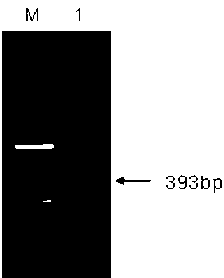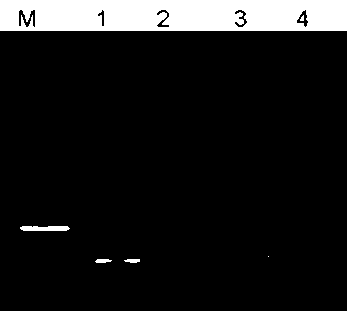Nile tilapia transforming growth factor TGF-beta 1 gene, related protein and application
A transforming growth factor, Nile tilapia technology, applied in the direction of transforming growth factor, anti-growth factor immunoglobulin, growth factor/inducing factor, etc., can solve the problem of tilapia disease, antibiotic deficiency, etc. Problems such as pertinence and poor effect of pathogenic bacteria variants
- Summary
- Abstract
- Description
- Claims
- Application Information
AI Technical Summary
Problems solved by technology
Method used
Image
Examples
Embodiment 1
[0040] Example 1 Synthesis of the Middle Fragment of Nile Tilapia Transforming Growth Factor β1 Gene
[0041] According to the homology comparison results of the cDNA sequence of the published fish transforming growth factor β1, a set of degenerate primers was designed and synthesized, and there was one upstream primer F1: 5'-GARGCBATTMGRRGHCAGAT-3' (shown in SEQ ID NO:7 ) and a downstream primer R1: 5'- GCMGAKGCWCCDGGRTTGTG-3' (shown in SEQ ID NO:8), wherein R=A / G; B=C / G / T; M=A / C; H=A / T / C; K=G / T; W=A / T; D=A / T / G. The cDNA obtained by reverse transcription of the total RNA of Nile tilapia spleen was used as a template and amplified by PCR method. The reaction conditions were: 94°C pre-denaturation for 3 minutes; the following was 40 cycles, divided into two stages: (1) Denaturation at 94°C for 30 seconds, 0.5°C per cycle from 65°C to 50°C, annealing for 30 seconds, a total of 30 cycles, extension at 72°C for 1 minute; (2) denaturation at 94°C for 30 seconds, annealing at 55°C...
Embodiment 2
[0044] Embodiment 2: the synthesis of Nile tilapia transforming growth factor β1 gene 3' end fragment
[0045] The upstream primer F2: 5'-TTTACCATGTCCATCCCTA-3' (shown in SEQ ID NO: 9) was designed according to the obtained intermediate fragment. According to the alignment of the existing fish transforming growth factor β1 cDNA, it was found that the stop codon was very Conservative, so a specific downstream primer R2 is designed here: 5'-TTAGCTACACTTGCAGGACTT-3' (shown in SEQ ID NO: 10). The cDNA obtained by reverse transcription of the total RNA of the Nile tilapia spleen was used as a template and amplified by PCR method. The reaction conditions were: 94°C pre-denaturation for 3 minutes; 94°C denaturation for 30 seconds, 55°C annealing for 30 seconds, and 72°C extension 30 seconds for a total of 30 cycles; 72°C extension for 10 minutes.
[0046] The electrophoresis identification chart of the PCR amplification product is shown in figure 2 . from figure 2 It can be see...
Embodiment 3
[0048] Embodiment 3: the synthesis of Nile tilapia transforming growth factor β1 gene 5' end fragment
[0049] Three downstream primers of 5'RACE, 5'-R1: 5'-GTTGAACCTGTTAAGCACCT-3' (shown in SEQ ID NO: 11), 5'-R2: 5, were designed based on the sequence of the cloned intermediate fragment of transforming growth factor β1 '-TGCTCCTCATCCTGCTTCT-3' (shown in SEQ ID NO: 12) and 5'-R3: 5'-CTGGTGCTGTTGTAGAGTGATAG-3' (shown in SEQ ID NO: 13) for nested PCR. For the first PCR, the total cDNA of Nile tilapia spleen was tailed by TdT as a template, 5'-R1 and universal primer 5'-CDS: 5'-AAGCAGTGGTATCAACGCAGAGTACGCGGG-3' (shown in SEQ ID NO: 14 ) as primers, amplified by landing PCR method, the reaction conditions are: 94°C pre-denaturation for 3 minutes; the following is 40 cycles, divided into two stages: (1) 94°C denaturation for 20 seconds, from 60°C to 50°C every (2) Denaturation at 94°C for 20 seconds, annealing at 50°C for 20 seconds, 20 cycles in total, extension at 72°C for 1 min...
PUM
 Login to View More
Login to View More Abstract
Description
Claims
Application Information
 Login to View More
Login to View More - R&D
- Intellectual Property
- Life Sciences
- Materials
- Tech Scout
- Unparalleled Data Quality
- Higher Quality Content
- 60% Fewer Hallucinations
Browse by: Latest US Patents, China's latest patents, Technical Efficacy Thesaurus, Application Domain, Technology Topic, Popular Technical Reports.
© 2025 PatSnap. All rights reserved.Legal|Privacy policy|Modern Slavery Act Transparency Statement|Sitemap|About US| Contact US: help@patsnap.com



